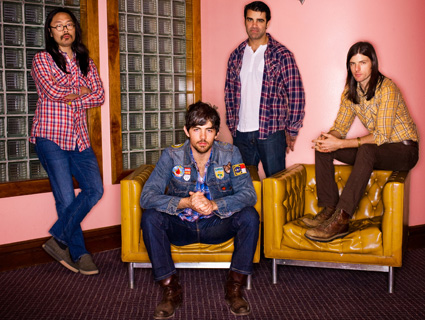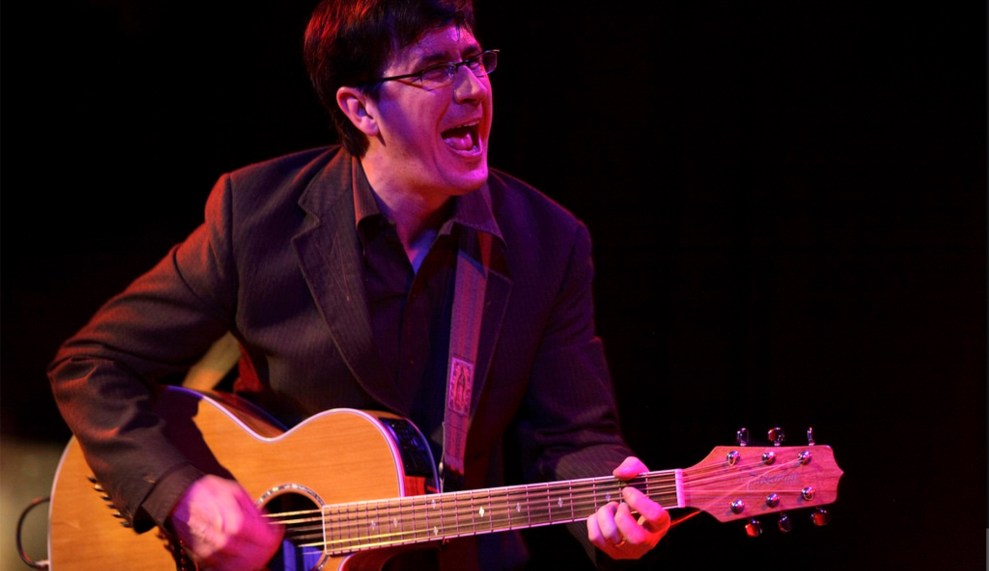
From left: Joe Kwon, Scott Avett, Bob Crawford, Seth Avett. Photo: Todd Roeth
For a decade now, the Avett Brothers, who hail from Concord, North Carolina, have been touring America, sharing their signature mix of bluegrass, folk, and rock with a devoted (and growing) cult of fans. The bandmates, brothers Seth and Scott Avett (banjo and guitar), Bob Crawford (stand-up bass), and tour cellist Joe Kwon, have always fared pretty well, but recently their status has skyrocketed.
In 2008, they signed with superstar producer Rick Rubin and American Recordings, and the following year they released the album I and Love and You to critical acclaim. Their songs have made appearances on American Idol and Friday Night Lights, and in February they played the Grammys, performing one of their own before teaming up with Bob Dylan and Mumford and Sons for a rousing rendition of “Maggie’s Farm.” But old fans need not worry: This shift in trajectory won’t mess with the Avetts’ rootsy vibe, promises kid brother Seth. “We already had a fan base,” he told me in a chat that veered from brotherly love to stop-time animation to Rick Rubin. “We weren’t at the mercy of the system. So, it was sort of a merging, rather than the big label signing the little man.”
Mother Jones: I hear you’re heading out on another big tour.
Seth Avett: We generally are like out for a week and then we’re home for four days and then we’re out for a week…that kind of deal. We just sort of never really stop. We’re offstage for the next 10 days, and then we’re going to be in Europe for about a week.
MJ: Isn’t that kind of exhausting?
SA: It is exhausting, but less than it was. We used to go out for six weeks at a time or whatever, but as we get older and as our families grow, you know, we get married and have kids and all that, we can’t just be out all the time. We’ve revised that. But performing is a big part of what we do. I can’t imagine it not being a part of it.
MJ: I noticed that your London show is sold out. You must have a good following in Europe.
SA: Your guess is as good as mine on that.
MJ: Are you proud to be bringing roots and traditional North Carolina music to a bigger audience?
SA: I never really think about it in terms of carrying on a tradition, although I’m sure that some of those elements are in place and are happening. We just try to present, in the most honest way, who we are and where we’re coming from. But that doesn’t necessarily mean we’re saying, “Hey, we’re from North Carolina, this is how North Carolina does.” I guess if you grew up somewhere where you never even saw a banjo, there would be some novelty attached to it—and sort of a danger to the novelty, primarily because of the pop-culture image of banjos: They’re obviously linked to poverty and rednecks and incest. [Laughs.]. But we’ve found that if the songs are good, or if the art is quality, and you’re presenting it as well as you can, that all of those aesthetic elements become very secondary. You know, you don’t have to come from Trinidad to really love Harry Belafonte, you don’t have to come from the West Coast to appreciate the simplicity and the beauty of the songs Kurt Cobain wrote.
MJ: I think your lyrics are accessible to people across the spectrum.
SA: Well, thank you for saying that. We just write from experience, and we’ve been very lucky to find a lot of like-minded and a lot of experienced people.
MJ: Tell me about your writing process.
SA: Scott and I do 99 percent of the writing. Bob writes as well and he helps arrange. We’re very conscious about staying away from a formula, because we don’t want it to get stale. That being the case, I might bring a complete song to the table. I might bring one that’s 90 percent there; I might bring one that’s 10 percent there. Or maybe I’ll just have one line. Sometimes Scott will play a few ideas for me, and the one that stands out to me is the one he thought was the weakest. We have sort of a built-in system for motivation in having two writers who are so close—having grown up together. We’re like-minded; it’s a rare occasion that we disagree or argue. Home life has changed in the last few years: Scott has a two-and-half-year-old and six-week-old, and we don’t have the time like we did to get together and work on songs. So we have been writing more separately. But we write in all different kinds of ways, and the songs come in all different kinds of ways. It’s a mysterious process to me—I can’t turn it on and off. It has its own ebb and flow.
MJ: How old were you guys when you started playing together?
SA: I mean, we were putting on show for our parents, pretending to be Hall & Oates, when we were little bitty kids, when I was four or five and Scott was eight or nine. And we sang in church throughout our childhood. And then we started really writing songs together when I was around 14 and he was around 18. We weren’t in a band together until I was around 19 and he was around 23.
MJ: A lot of people might have trouble working this closely with a sibling.
SA: Yeah, I hear there are those that do have trouble with it. Scott and I, one of their greater things about our traveling together early on was that we knew that we would back each other up and that we would protect each other. Starting a band, starting an outfit like that out of love, and with care, is a very solid foundation to start on. It’s ideal for any kind of endeavor, but especially a business endeavor, and an artistic endeavor. I haven’t really come across any downside.
MJ: Your video for “Head Full of Doubt, Road Full of Promise” is a stunning example of stop-time artistry. How did you pull it off?
SA: The artist, Jason Ryan Mitcham, has been a friend of ours for many years. He and Scott went to East Carolina University together and were both in the painting department at the same time. He’s a very skilled landscape painter and just a marvelous artist, a very talented guy. He came to us with the idea. Initially he had been developing images for a song of ours from a record called The Second Gleam, and the song was called “Tear Down the House.” In his own work, he’d been exploring the themes of development, the way the world is changing, the way civilization is changing. And when he heard “Head Full of Doubt,” he heard those things in his translation. That was the common ground. It was really all him. We okayed different thoughts on it, and talked about it, but it was completely an original work of art on his part. (Watch it below, and then read on.)
MJ: I can’t even imagine how long that must have taken.
SA: I don’t remember the numbers, but it was something unbelievable. I know it took him—spending six, seven hours every single day on it—three months or something like that. You have to be completely dedicated, and he was. He actually did just the first 30 seconds or whatever, which took him weeks—he just submitted it to us and our label to kind of see the idea, and we were just obviously blown away and we were like, “Yes, let’s make this happen.” It was such a beautiful process, and such a traditional process, in a time where people are looking for shortcuts.
MJ: You guys are known for putting on a great show. With such a balance of up- and down-tempo songs, how do you keep things lively?
SA: Well, I think we feed off of the audience in a big way. We’re very much a band that takes into account the feeling in the room, the feeling in the field, wherever we are. It’s a great exchange between the stage and the audience. And you know, sometimes we won’t play hardly any down-tempo songs—the day just calls for a full-on, rip-roaring set. We just started writing set lists like a year ago.
MJ: And before that you’d just wing it?
SA: Oh, yeah. I would just start one or Scott would start one or we would confer just for a moment. So the set list thing is still very new for us. We keep it real fluid—we’ll change it at the drop of a hat. There’s logistics to it; sometimes you need a break. We put a lot of energy and a lot of effort into our live performances because in our minds, every time we perform, that’s one less time in our lives that we’ll get to do this. We take it real seriously and we do have fun with it, but it is in the back of our minds that tonight might be the first time someone out there is ever seeing you, and you don’t want to let them down. I guess that’s what people are responding to. I’m glad you’ve heard the show is great.
MJ: So has signing with Rick Rubin and Columbia Records changed things for you?
SA: Yeah, it’s changed some things…for the better. Before signing on with Columbia, we didn’t have the time or the finances behind us to really spend the kind of time we wanted to make the record. So that’s been a major difference. Our previous record, Emotionalism, we recorded the whole thing in 11 days. That’s everything: mixing, mastering, overdubs, all of it. And I can appreciate the charm of that, and some people prefer that, in a way, but we want to create the best art we can, and sometimes it takes more than 11 days to make a record. Artistically, that’s been good—to have a little less urgency on it. And we have a higher level of ability and more tools to get what we want to get out of our recording sessions. Business-wise, there’s just a bigger team to communicate with—we stepped into a major label deal with almost a decade’s worth of experience and a certain amount of leverage because of that.
MJ: What, specifically, has Rubin taught you?
SA: To break a song down and to build it back up from the ground, rhythm-wise. It’s funny, you know, we played for so long without any kind of producer at all; we played thousands of shows, just me and Scott and Bob, so our rhythm was terrible. It’s not like it’s all that great now, but it was just us three, so we’d just speed up, slow down. Sometimes that’s good, but other times you need more stability there. That’s the kind of thing we learned from Rick. We learned about how songs work better in an arrangement, and putting more effort into the arrangement, and putting more time in. And taking the time to experiment. Rick is big on saying, “Hey, I got an idea, and it might be terrible.” And our attitude is: Yeah, okay, we’ll find out. You don’t know until you try. Maybe accordion on this song is going to be just ridiculous and just silly, but maybe it’ll be beautiful.
MJ: How far are you on your next album?
SA: I would say we’re probably 75 percent of the way, if not more. Like any endeavor, it’s always taking three times longer than you thought. We’re working on so many songs; there could be some creative ways to release some of them. Right now, we’re seeing through to total completion like 24 songs or something like that. So I don’t know how that’s all going to go down. But I’d love to see the album come out early 2012.
MJ: Last question. Will you play “Laundry Room” when you come to Oakland?
SA: [Laughs.] Yes, I will do my best to keep that in my mind, Karmah.
Click here for more Music Monday features from Mother Jones.








